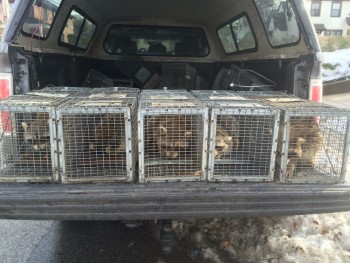
RACCOONS IN THE ATTIC - NASSAU COUNTY, NEW YORK
How Do I Know If There Are Raccoons In The Attic?
Raccoons are nocturnal animals, so if you hear loud noises in the attic at night, it is most likely from raccoons. If a raccoon is entering an attic via an attic fan, you might hear a loud thud followed by heavy walking in the attic of your Long Island residence. Raccoons make more than two hundred vocal sounds, including growling, snarling, whimpering, hissing, and screeching. Evidence that raccoons inhabit your attic may include raccoon footprints on your gutter leaders and siding or feces on the roof. Other wildlife that is active in attics at night include mice, rats, bats, and flying squirrels. Therefore, it is always best to contact a wildlife control operator for a wildlife inspection to determine what animal is inhabiting your attic.

Why Are There Raccoons In The Attic?
Raccoons do not build their own dens and usually seek shelter inside tree hollows in rural areas. However, in urban and suburban areas of Long Island, trees have been cut down to erect houses and buildings. Consequently, there are fewer trees for raccoons to seek refuge in urban and suburban areas. Additionally, raccoons are more densely populated in urban and suburban areas than in rural sectors. According to the New York State Department of Environmental Conservation statistical data, raccoon populations on Long Island may exceed one hundred raccoons per square mile. The overpopulation of raccoons on Long Island results from the lack of predators, which ordinarily would include bobcats, cougars, and coyotes. In the absence of nocturnal predators, motor vehicles represent the most significant threat to a raccoon's life on Long Island. It is estimated that motor vehicles in the United States annually kill fifteen million raccoons. Raccoons are nocturnal animals, which may account for the high raccoon roadkill numbers.
To avoid potential predators, raccoons will usually seek shelter above ground. Raccoons are skilled climbers and, in most cases, can easily access roofs using the brickwork of chimneys built onto the sides of homes, gutter leaders, or tree branches that contact the roof. Once on the roof, a raccoon may tear a hole in it to gain access to the attic. Raccoons also access attics via the soffits, attic fans, and gable vents. The warmth, darkness, and protection provided by a Nassau County residence's attic make it an ideal raccoon den site. Raccoons usually enter attics in Nassau County in the spring, when female raccoons are searching for a place to give birth to their offspring. However, raccoons can reside in attics year-round and frequently seek out the warmth of Nassau County, Long Island attics during the winter.
How Do I Know If There Are Raccoon Pups In The Attic?
A female raccoon, known as a sow, will breed with a male raccoon, also known as boar, between January and June. Female raccoons have a nine-week gestation period and give birth to an average of four raccoon pups. However, raccoons can give birth to as many as seven kits. An attic of a Nassau County home is a dry place with an abundance of insulation that mother raccoons will use to keep their offspring warm. Raccoon pups make a high-pitched chattering noise, which sounds like birds in the attic.
What Kind Of Damage Can Raccoons Do In The Attic?
Raccoons can do a lot of damage in the attics of Nassau County homes. Raccoons in the attic often destroy the ductwork of central air conditioning systems. Raccoons frequently use the attic as a latrine, which generally requires attic cleanup and restoration services.
How Do I Get Rid Of Raccoons In The Attic?
As tempting as it may be, don't bang on a ceiling when you hear a raccoon above it. When raccoons occupy your home, it is almost always a mother with a litter of pups. Banging on a ceiling will not result in her leaving your house and only serves to stress the mother raccoon. A stressed mother raccoon usually moves her offspring to a more secure place in your home; very often, that place will be under a bathroom tub. Wildlife repellents, including ultrasonic devices, coyote urine, and mothballs, do not get rid of raccoons and will only serve to stress a mother raccoon. A lactating mother raccoon in an attic is very protective of her pups and highly aggressive against intruders, so entering the attic is not a good idea. Lactating raccoons are usually extremely trap-shy and will not enter a food-baited trap. A better option would be to contact the wildlife control experts at Nassau County Nuisance Wildlife Removal Services. The raccoon removal strategies that our Long Island wildlife control experts use are contingent upon the circumstances and where the raccoons are entering your residence or business.

